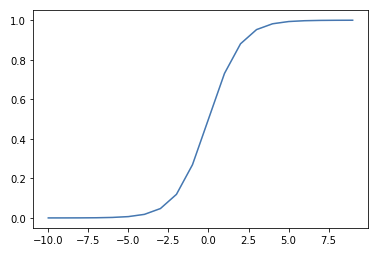Sigmoid Function

The Sigmoid function, also known as the Logistic Function, squeezes numbers into a probability-like range between 0 and 1.1 Used in Binary Classification model architectures to compute loss on discrete labels, that is, labels that are either 1 or 0 (hotdog or not hotdog). The equation is:
S(x)=11+e−x
Intuitively, when x is infinity (e−∞=0), the Sigmoid becomes 11 and when x is -infinity (e∞=∞) the Sigmoid becomes 1inf. That means the model is incentivised to output values as high as possible in a positive case, and low for the negative case.
[@foxMachineLearningClassification]
It is named Sigmoid because of its S-like Function Shape. Its name combines the lowercase sigma character and the suffix -oid, which means similar to.
It can be described and plotted in Python, as follows:
import math, matplotlib.pyplot as plt
def sigmoid_function(x):
return 1/(1+math.e**(-x))
inputs = list(range(-10, 10, 1))
labels = [sigmoid_function(i) for i in inputs]
fig,ax = plt.subplots(figsize=(6,4))
ax.plot(inputs,labels)
plt.show()
-
Technically, there are many Sigmoid functions, each that return different ranges of numbers. This function's correct name is the Logistic Function. An alternative function that outputs values between -1 and 1 is called the Hyperbolic Tangent. However, in Machine Learning, sigmoid always refers to the Logistic Function. ↩